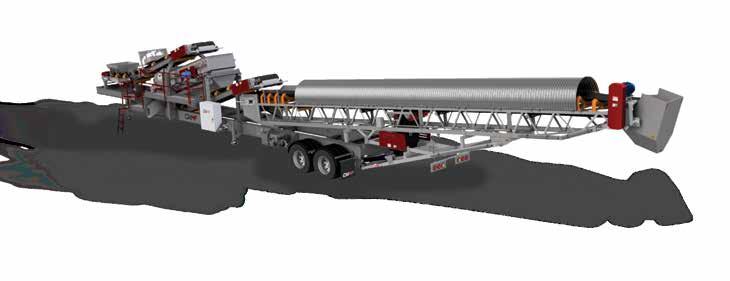
3 minute read
Industry Numbers for Suicide Prevention
BY ASPHALTPRO STAFF
Editor’s Note: All data and quotes herein are from the Peterson C, Sussell A, Li J, Schumacher PK, Yeoman K, Stone DM, “Suicide Rates by Industry and Occupation—National Violent Death Reporting System, 32 States, 2016.” MMWR Morb Mortal Wkly Rep 2020;69:57–62. Read this report online at https://www.cdc.gov/mmwr/volumes/69/wr/mm6903a1.htm.
Getting up-to-the-minute data isn’t easy. Getting current data from a government entity is harder yet. In 2016, the National Violent Death Reporting System (NVDRS) offered data showing suicide rates by industry and occupation, gathered from 32 participating states.
The U.S. Department of Health & Human Services Center for Disease Control and Prevention (CDC) summarized in its Morbidity and Mortality Weekly Report from Jan. 24, 2020, that we already know suicide among the U.S. working-age population is increasing. What the report added to the conversation was room for interpretation.
“NVDRS data from 32 states were used to calculate suicide rates for major industry and occupational groups and detailed occupational groups,” the report stated. This is of interest to the asphalt industry because safety directors and middle managers concerned about the welfare of their workers have been finding some upper-level managers hesitant to tackle the subject without proof that suicide and/or mental health struggles are truly affecting our industry. As a reporter for this industry, I have attended webinars and zoom calls where more than one individual requested hard data for the asphalt sector of the construction industry. As we will see in the following paragraphs, “construction and extraction” leads the nation in successful deaths by suicide at a rate of 49.4 per 100,000 civilian, noninstitutionalized, working population, but sometimes upper management requires more exact data before allocating company resources to a new tier of the safety and health program.
It takes uncomfortable effort to wade through statistics of decedents to determine their exact professions and decide whether to classify them as former members of the asphalt industry. For example, the 2016 NVDRS data broke out five major industry groups that had suicide rates higher than the study population by sex. In order, those included mining, quarrying, and oil and gas extraction; construction; other services such as automotive repair; agriculture, forestry, fishing, and hunting; and transportation and warehousing. (Supplementary Table 1 at https:// stacks.cdc.gov/view/cdc/84274 offers the complete statistics on this list and I recommend reviewing it and sharing it with your upper management as needed.)
The 2016 NVDRS data also broke out six major occupational groups that had suicide rates higher than the study population by sex. In order, those included construction and extraction; installation, maintenance, and repair; arts, design, entertainment, sports, and media; transportation and material moving; protective service; and healthcare support.
We can drill down to the industry and occupation of electrician, operating engineers, laborers, trucking or mechanics to reasonably deduce those numbers include asphalt professionals who are no longer with us. As the authors of the report suggest: “Suicide rates for detailed occupational groups provide insight into subcategories within major groups.” Some of the detailed group level categories for males include machinists (from the “production” major group); welding, soldering, and brazing workers (from the “production” major group); and construction managers (from the “management” major group). “Rates for detailed occupational groups (e.g., Electricians or Carpenters within the Construction and Extraction major group) are presented and provide insight into the differences in suicide rates within major occupational groups.”
Persons experiencing a crisis are encouraged to call or text the Suicide and Crisis Lifeline at 988.
By extrapolation, we can also assume these numbers increased in 2017, as the overall number of decedents increased from 15,779 in 2016 to 38,000 the following year. Gathering statistics for our industry is further complicated by the opioid problem in the construction industry, which will be discussed in session SH8 at CONEXPO-CON/AGG. Join Presenters Cal Beyer and John Gaal in the West Hall 206 at 2:30 Wednesday. Safety managers seeking ideas for “Constructing a Culture of Suicide Prevention” are encouraged to attend the panel discussion moderated by Michelle Walker. That session, SH11, will be Thursday at 10:45 in the West Hall 216-218. However you elect to share the numbers, the problem is real. Now that we’ve identified it, we can work together as an industry to erase the stigma behind mental health struggles and help our co-workers find solace.
Select Industry Groups With Numbers
While there may be additional asphalt industry workers “hidden” within other occupational groups, we can reasonably assume these groups include members of the asphalt industry who died by suicide in 2016. The rate listed in column two is per 100,000 civilian, noninstitutionalized working persons aged 16-64 years with a confidence index of 95%. Visit the Supplementary Table 2 at https:// stacks.cdc.gov/view/cdc/84275 to see data for rates calculated for 118 detailed occupational groups for males and 32 for females. Source: https://www.cdc.gov/mmwr/volumes/69/wr/mm6903a1.htm#






